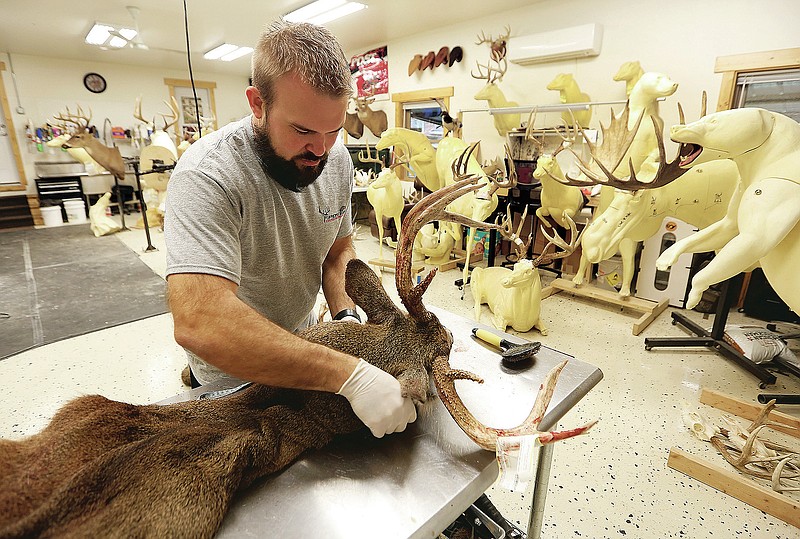DUBUQUE, Iowa -- Branden Post quickly but carefully cut away the skin from a deer head using a scalpel at his taxidermy studio in Dubuque.
Tools of his trade filled the room set up at his house -- forms in the shape of different game, tables laden with animal skulls, fish hanging from a shelf.
"I do this for a business, but I want to do the best possible work," said the owner of Post Taxidermy. "There's taxidermists, and then there's artists. I say I'm more of an artist-taxidermist."
Post is among multiple local taxidermists wrapping up one of their busiest seasons of the year as area hunting seasons wind down.
For area taxidermists, the drive to practice their trade comes from their own love of hunting and the many stories that come with it.
"I've always been a hunter and fisherman," said Tom Pregler, who owns Tom's Taxidermy in Dubuque. "To me, it was just a natural extension of what I enjoyed doing outside, and it became somewhat of an obsession."
Pregler's most common customer requests are for shoulder mounts of white-tailed deer.
To create a mount, Pregler removes the skin from the head of the deer and removes all the meat and muscle before sending the hide to a tannery. Once the tanned hide comes back, he slips it onto a form and glues it in place. He purchases glass eyes and molds them into the form using clay.
"You move the hide and position it so that, hopefully, it looks alive when you're done," he said.
Pregler can make mounts of "anything that walks or crawls," though he doesn't do people's pets.
"(White-tailed deer are) by far the bulk of what I do, and second to that would be birds and fish," Pregler said. "It's based on geography as much as anything. If I was out West, it would be elk and mule deer and that kind of thing. But we're in Iowa, and that's what we hunt here."
Post said completing a mount takes about 13 to 15 hours of hands-on work, but it can take six months to a year for customers to receive the final product because of the volume of pieces he has to complete. He averages about 250 pieces each year among deer, birds, fish and other animals.
He said one of the most unusual taxidermy requests he has received was from a customer who asked him to mount a deceased pet zebra.
"I ended up mounting three zebras for him," Post said. "They all passed away of old age. ... That one's different living in Iowa -- trying to do your pet zebras."
Jerry Donar, who owns Georgetown Taxidermy near Cuba City, Wis., holds a full-time job and does his taxidermy work when he is at home and on weekends, typically spending about 30 hours a week in the shop. That gives him time to complete about 80 deer mounts a year.
In addition to creating taxidermy mounts, he also does his own tanning.
"I've had a few bad occurrences with tanners, and I trust me," he said. "And the most part of the money is in tanning it yourself."
Donar said he particularly appreciates the chance to get to know his customers.
"I just enjoy putting the whitetails back together, recreating the way they look," Donar said. "I also enjoy the hunting stories -- they're always amazing -- from the customer. That's probably the biggest thing, the stories."
Post's interest in taxidermy started when he was about 10 years old. As a young hunter, he never liked to throw anything away, so his father bought him a kit to mount a squirrel that still hangs above the door to his studio.
After finishing high school, he attended a semester of college before he decided instead to go to school to learn the trade of taxidermy. He has now been a full-time taxidermist for 15 years.
"Anybody can do it, but for it to look real and alive, you've got to be an artist, plain and simple," Post said.
He, Pregler and Donar all said their love of hunting ties in with the things they enjoy about their trade.
"Being a hunter and fisherman, I like hearing stories and telling the stories and seeing the bucks that come in," Pregler said. "It's promotion of the sport for me."
He also appreciates the fact that his work -- which he does part time in his retirement -- is never boring.
"If I get tired of mounting deer heads, I'll pull out a raccoon to mount, and if I get tired of doing raccoons and deer, I'll pull out a pheasant or a fish. There's always something different to do," Pregler said.
While his customers most often want an animal mounted for its quality or size, many of them have sentimental reasons, too.
"It's a trophy for them in some way, whether it was their kid's first deer, or 'I was with my dad when I shot that,'" Pregler said. "... A trophy is in the eyes of the beholder."

Distributed by The Associated Press.

